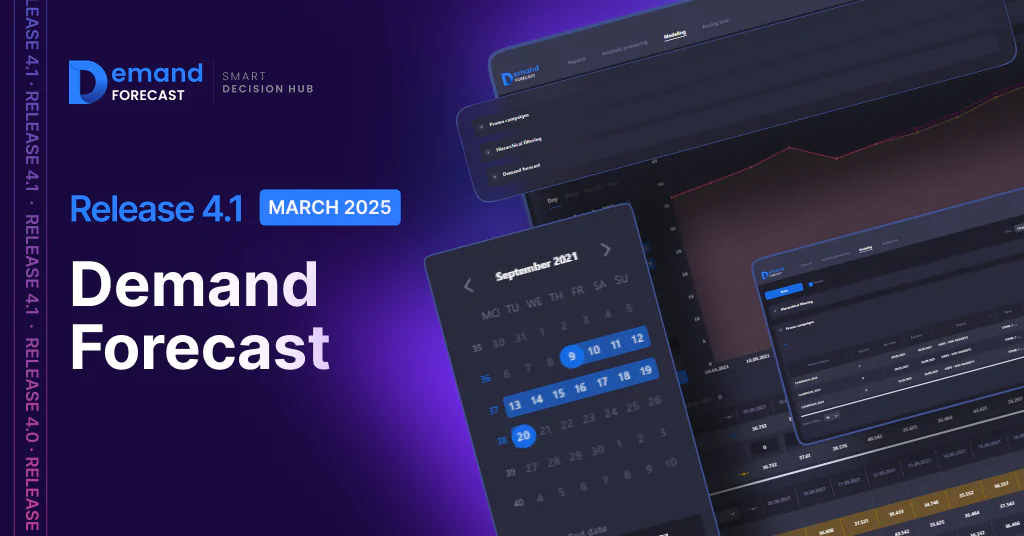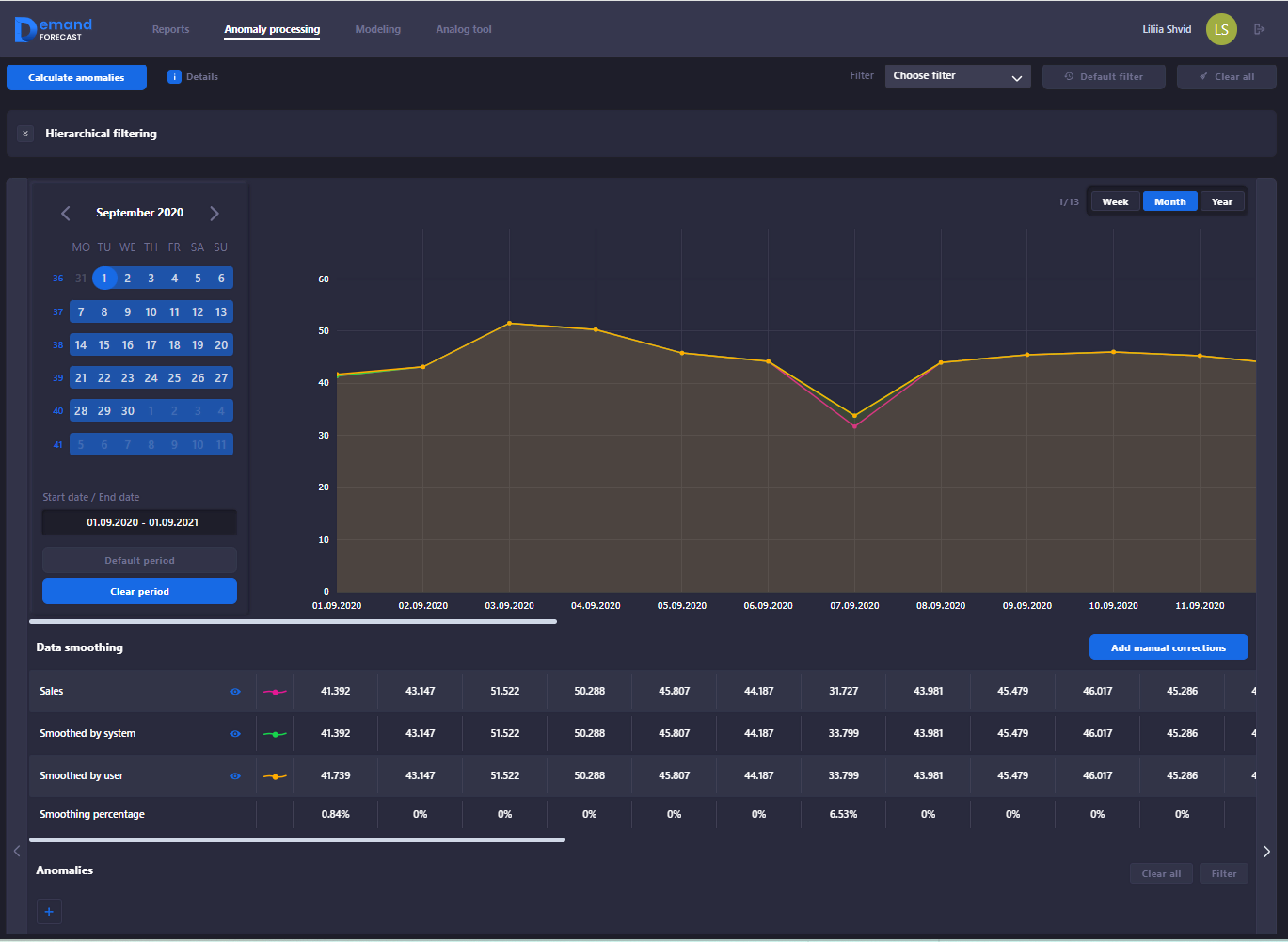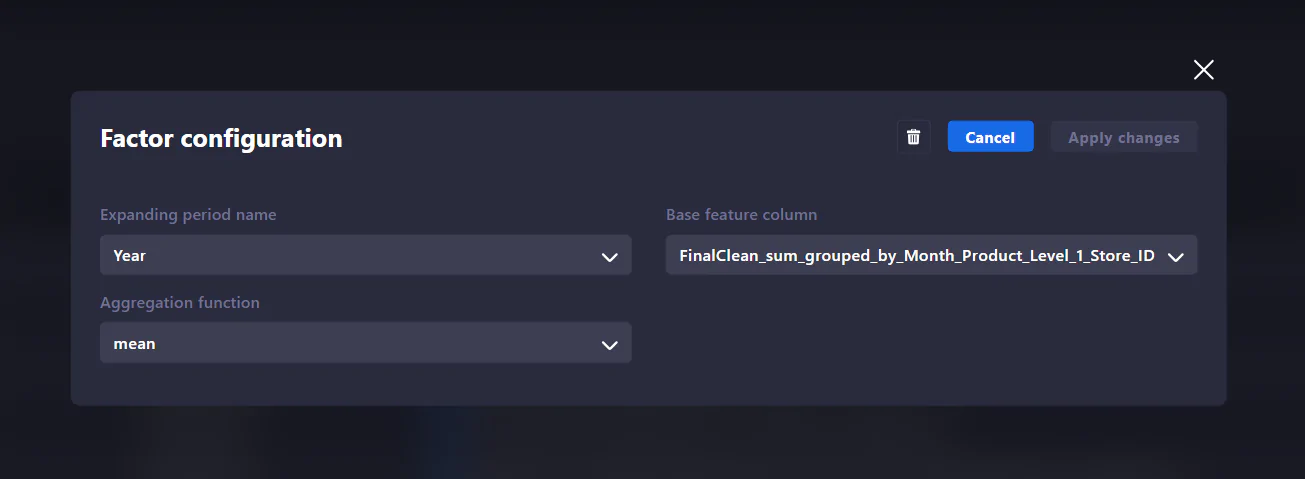31 Mar 2025 7 MIN READ
Release 4.1. SMART Demand Forecast: Making Forecasting Even More Convenient

Enhancing demand forecasting accuracy is crucial for efficient inventory management, optimizing production processes, and improving financial performance. The ability to accurately predict demand helps reduce excess inventory, avoid stock shortages, and ultimately increase company profits.
Today, demand forecasting systems are key tools for competitiveness across businesses of all sizes. With the new 4.1 release, we have made SMART Demand Forecast more convenient and faster, enabling you to achieve even more precise forecasts and grow your business.
Let’s take a look at the key updates:
Partial Deployment of Infrastructure by Blocks
We have implemented partial deployment of infrastructure in separate modules, which helps reduce cloud resource costs, especially during the pilot forecasting stage.
Function Migration to .Net Isolated
Security and performance have been improved by migrating the functions to .NET Isolated and updating the Azure Function configuration. This ensures stable support by developers, simplifies updates, and significantly boosts system security and performance.
System Update to .NET 8.0
Several portal components have been updated to introduce crucial system improvements. Upgrading the platform to the latest .NET version enhances stability, performance, and enables support for the newest technological capabilities.
Azure Function Configuration Changes
We optimized the infrastructure by migrating Azure Function to a shared AppService Plan, reducing cloud component costs and simplifying resource management while maintaining system stability at lower expenses.
Migration of the Analytical Model from SQL Dedicated Pool to Databricks
As part of our analytics model modernization, computations have been migrated to Spark, with data storage in Datalake. This enables scaling for large data sets and complex calculations without compromising performance.
DAX Power BI Metric Calculations Optimization
We optimized queries and updated the data storage structure, reducing resource usage and speeding up report generation.
Overall Optimization of the Analytical Model
A comprehensive optimization of the analytical model has significantly improved the efficiency of data processing and ETL processes. This results in faster loading, processing, and analysis of large data volumes.
Migration of Power BI Data Sources to Delta Tables
We updated data sources and connections, enabled by analytical model optimization. This transition has optimized data storage and accelerated analytical queries. As a result, system load is reduced, data processing costs are lowered, and the speed of analytical reporting is improved.
Improved File Import and Export
We standardized and optimized file import and export processes, automating structural validation. This means less manual work, a lower risk of errors, and higher data quality. As a result, working with files is faster, simpler, and more efficient for your business.
Promo Campaign Administration Functionality
The new functionality allows you to quickly and easily enter data for all points of sale in a single line. The system automatically distributes the information for each sales point, minimizing the risk of errors. This significantly speeds up the campaign management process and enhances your team’s efficiency.
The Ability to Exclude New Products/Stores from Analytics
You can now manage analytics more flexibly by excluding new products or stores from forecast accuracy calculations. This helps avoid data distortions that may arise from the incomplete sales history of new products or stores. With this feature, your forecasts become even more accurate, and your management decisions more grounded.
Deduplication Added to Every Table in the Universal Data Structure
Data quality is the foundation for accurate forecasting and effective business process management. We have implemented duplicate checks in every table of the universal data structure to prevent erroneous duplication of information. This enhances trust in analytics, ensures the correctness of calculations, and makes the decision-making process even more precise.
ItemLifeCycle Report
The product lifecycle is a key factor in assortment planning, inventory management, and sales forecasting. We have developed the automated ItemLifeCycle report, which provides detailed analytics at each stage of the product lifecycle. This allows you to make informed business decisions, optimize stock levels, and plan purchases more effectively.
Improved UX/UI and Usability
Although the system is designed for precise mathematical calculations, we never forget that it’s built primarily for users. That’s why we continuously enhance your interaction with the SMART Demand Forecast system. Here’s what has been implemented in this release:
- Explored and Implemented Lazy Loading for Interface Rendering Optimization
Lazy Loading allows critical elements of the page to load first, while non-critical elements load gradually, which is particularly important for users with slow network connections.
- Optimized Page Performance
We reduced the number of elements on the page and limited API requests during the execution of main business processes. Pages now only display the necessary system performance indicators, and API requests are made after important processes have been completed. This reduces the load on the system, which is important for users with less powerful devices or poor network connections.
- Convenient Settings Navigation Panel Added
We added a navigation panel for main pages within the interface. This update simplifies and speeds up navigation within the system, improving the user experience.
- Improved Interface Interactivity
Enhancements have been made to user interaction with the system, making the interface more user-friendly, dynamic, and appealing. This includes improvements to the system elements users interact with daily – making all necessary tools more accessible.
- Explored and Implemented Lazy Loading for Interface Rendering Optimization
Improved Machine Learning Algorithms
We have enhanced the machine learning algorithms by optimizing the code for Data Science processes, speeding up modeling and scoring, which form the basis for forecasting. This results in higher model performance and faster calculations.
New Opportunities Found for Handling Anomalies
Anomalies in data can distort forecasting, leading to errors, so we address them in every release. Here’s what we’ve improved:

- Optimized Anomaly Calculation and Upload Process
The database entry for anomalies has sped up by 30–40%. Thanks to process modifications, calculations are faster and handling large datasets is more efficient. This enables the business to respond quickly to unusual situations and improve forecast accuracy. - Improved STL and Autoencoder Algorithms
This helps better identify deviations and provide more accurate forecasts. As a result, you can more effectively manage inventory, optimize supply processes, and reduce financial risks for your business. - Optimized Default Period Calculation on the “Anomaly Processing” Page
A check for the first sales day has been introduced to avoid empty columns appearing in the tables. Now, period selection is more intuitive, and data display is more accurate.
Data Science Processes Migrated from Azure Machine Learning to Azure Databricks
This migration allows for even faster and more efficient handling of large data volumes thanks to a distributed framework optimized for high-load tasks. Additionally, the migration opens scaling opportunities and reduces solution costs.
Data Science Dashboard with Factor Builder
The launch of the Data Science Dashboard with a customizable and saveable Factor Builder provides flexible tools for modeling. Implementing the Factor Builder significantly reduces the time spent on pilot experiments and minimizes the potential human error during testing.

TFT Model Replaced with Meta’s Prophet
We have improved forecasting algorithms by replacing the TFT model with the powerful Prophet. This enables even more accurate and flexible forecasts, improving adaptability to seasonality, trends, and market instability.
Adapted Architecture for Omnichannel Forecasting
For any solution, we conduct thorough analysis and preparation. We have laid the groundwork for future updates in sales forecasting across channels, allowing for deeper analysis of demand dynamics and better assortment optimization. This now provides us with a clearer picture for decomposing functionality in the next release.
